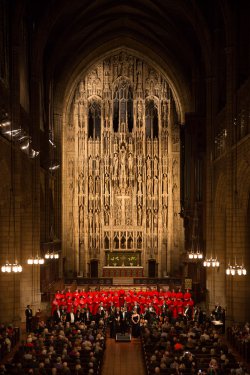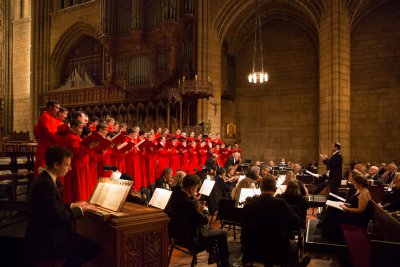The Saint Thomas Choir of Men and Boys with Orchestra of St. Luke’s: Mozart’s Requiem & Haydn’s Missa in Angustiis
A beautiful performance of two familiar 18th century sacred choral masterpieces, and a fitting memorial to a much loved church musician, deeply mourned.

Haydn’s “Missa in Angustiis” (Nelson Mass) presented by The Saint Thomas Choir of Men and Boys with Orchestra of St. Luke’s with Guest Conductor Andrew Nethsingha (Photo credit: Ira Lippke)
[avatar user=”Jean Ballard Terepka” size=”96″ align=”left” ] Jean Ballard Terepka, Music Critic[/avatar] The first concert of The Saint Thomas Choir of Men and Boys 2015-2016 Season was beautiful. The church was packed; singers and musicians alike were wonderful. The evening was both a splendid memorial to John Gavin Scott (1956-2015) and a strong beginning to whatever will be the next musical leadership at St. Thomas.
Scott was Organist and Director of Music at Saint Thomas Church from 2004 until his sudden, entirely unforeseen death from cardiac arrest in August of this year. His church musician career – as both choir director and organist – was international in scope; his capacity to instill excellence in young people and inspire it in colleagues, together with his rare artistry, made him a leader in contemporary classical music in general and in sacred music in particular.
Before his death, Scott had planned the repertoire of the whole 2015-2016 season. The fact that the very first work was Mozart’s Requiem was entirely a matter of poignant chance. Before the concert, the Reverend Canon Carl F. Turner, Rector of Saint Thomas, addressed the audience. He noted that it was fitting that the first work – Mozart’s Requiem – of what was Scott’s final planned season – was an unfinished piece: Scott’s influence will not end.
And indeed, the coherence of the performance was as much Scott’s legacy as the discipline of the current musicians. Stephen Buzard, the church’s Acting Director of Music and Benjamin Sheen, Acting Organist, together with the Saint Thomas Choir School’s Headmaster, Rev. Charles F. Wallace, have all clearly kept the choir and school – the adult and treble singers – running smoothly in the midst of sadness. But particular credit for this fine performance goes to guest conductor, Andrew Nethsingha, Director of The Choir of St. John’s College, Cambridge, UK.

Haydn’s “Missa in Angustiis” (Nelson Mass) presented by The Saint Thomas Choir of Men and Boys with Orchestra of St. Luke’s with Guest Conductor Andrew Nethsingha (Photo credit: Ira Lippke)
Nethsingha’s reading of Mozart’s Requiem was richly nuanced and widely expressive, and the success of his reading was established within the first three movements. The opening Requiem was graceful, nearly pensive: the treble voices were sweet and pure, and soprano Katharine Dain’s brief opening solo was at once eloquent and ethereal. The swift Kyrie, with its tight runs, quarter and sixteenth notes, was a completely clear, crisp introit, an urgent summons of the clergy to their sacraments. The ensuing Dies Irae – one particularly pure exemplar of Mozart’s genius – made beauty and terror inseparable.
The Mozart-Sussmayr Requiem, with its symmetrical architecture, makes for a lush, expansive musical experience. Nethsingha provided just this: he led the ten boys and ten men of the choir, the splendid Orchestra of St. Luke’s and the four soloists as though they were a group of musicians who had collaborated daily for years rather than a collection of singers and instrumentalists gathered together from across two oceans, several states and at least three countries.
Haydn’s wonderful Missa in Angustiis, sometimes called the Nelson Mass, is a work of large vision, a constant swing between dark and light, between uncertainty and triumph. This particular performance, however, was one which consistently found much more joy than fear.
The Credo – rendered almost as a narrative by Haydn more than as a theological statement – was, in the end, dominated by happiness, and the Pleni sunt coeli section of the Sanctus was like a dance of delight.
The orchestra was consistently lush and rich, and the balances of choir sections, orchestra and soloists were effective, no part or voice ever overpowered by the others.

Haydn’s “Missa in Angustiis” (Nelson Mass) presented by The Saint Thomas Choir of Men and Boys with Orchestra of St. Luke’s with Guest Conductor Andrew Nethsingha (Photo credit: Ira Lippke)
In both the Mozart and the Haydn, there are no single, long bravura moments for the soloists, though the soprano gets a longer turn than the others. However, there are many times, over a stretch of a small number of phrases, sometimes even only a few bars, when soloists provide an important clarity of insight or a spiritual turning point. Mezzo-soprano Brenda Patterson’s rich but lyrical voice consistently offered tremendous subtlety of feeling. Tenor Dann Coakwell sang with both authority and freshness. Bass Charles Perry Sprawls used his deep, strong voice to convey emotions ranging from rage to poignancy, and pleading to exhilaration.
In the Haydn especially, the four soloists had several brief quartets – the Amen at the end of the Gloria, portions of the Benedictus and the Agnus Dei – which were especially wonderful. Their voices were well matched in several combinations – by gender, by soprano/tenor and alto/bass pairs as well as by soprano/bass and alto/tenor pairs – and Nethsingha conducted them so as to turn Haydn’s harmonies, rhythms, surprises and resolutions into human conversations on sacred subjects.
The final Dona nobis pacem of the Haydn seemed more a triumphant certainty that peace will ultimately come than a mere request for it.
For both the confident optimism of this concluding music of the concert and for the excellence of the performance, singers and musicians were rewarded with jubilant applause and, for the boys especially, a standing ovation.
Under any circumstances, this concert would have been a splendid beginning of the season. That the performance was so fine was also both a fitting memorial to John Scott and, in unexpected and important ways, a gift from Scott to us.
The Saint Thomas Choir of Men and Boys with Orchestra of St. Luke’s: Mozart’s Requiem & Haydn’s Missa in Angustiis (November 12, 2015)
Saint Thomas Church Fifth Avenue
1 West 53rd Street, in Manhattan
For more information, see http://www.SaintThomasChurch.org
Running time: two hours including one intermission






Leave a comment